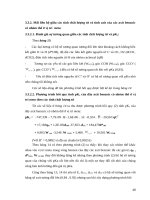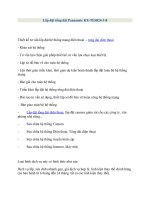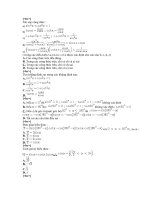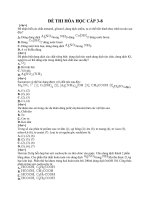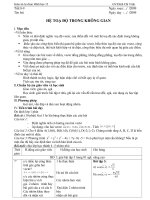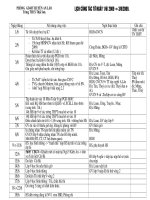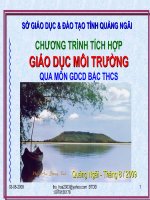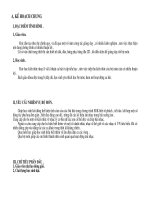Bsi bs au 050 3 8 1985 (2001)
Bạn đang xem bản rút gọn của tài liệu. Xem và tải ngay bản đầy đủ của tài liệu tại đây (261.99 KB, 10 trang )
BRITISH STANDARD AUTOMOBILE SERIES
BS AU
50-3.8:1985
Incorporating
Amendment No. 1
Tyres and wheels —
Part 3: Valves —
Section 8: Code of practice for the
selection and care of tyre inflation
valves for commercial vehicles
UDC 629.113.012.551 – 396.2
NO COPYING WITHOUT BSI PERMISSION EXCEPT AS PERMITTED BY COPYRIGHT LAW
BS AU 50-3.8:1985
Committees responsible for this
British Standard
The preparation of this British Standard was entrusted by the Automobile
Standards Committee (AUE/-) to Technical Committee AUE/4 upon which the
following bodies were represented:
Agricultural Engineers’ Association
British Industrial Truck Association
British Pressure Gauge Manufacturers’ Association
British Rubber Manufacturers’ Association
Bus and Coach Council
Department of Transport
London Transport Executive
Ministry of Defence
Motor Cycle Association of Great Britain
Motor Industry Research Association
Retread Manufacturers’ Association
Road Haulage Association Ltd.
Society of Motor Manufacturers and Traders Limited
This British Standard, having
been prepared under the
direction of the Automobile
Standards Committee, was
published under the authority
of the Board of BSI and
comes into effect on
28 February 1985
© BSI 06-2001
The following BSI references
relate to the work on this
standard:
Committee reference AUE/4
Draft for comment 84/71549 DC
ISBN 0 580 14327 9
Amendments issued since publication
Amd. No. Date of issue
11053
June 2001
Comments
Indicated by a sideline
BS AU 50-3.8:1985
Contents
Page
Committees responsible
Inside front cover
Foreword
ii
8.1 Scope
1
8.2 Valve selection by vehicle manufacturer
1
8.3 Types of valves
1
8.4 Valve fitting checks
2
8.5 Valve accessibility
2
8.6 In-service valve checks
2
8.7 Check list for care of inflation valves for commercial vehicles
2
© BSI 06-2001
i
BS AU 50-3.8:1985
Foreword
This section of BS AU 50-3 has been prepared under the direction of the
Automobile Standards Committee. This code of practice gives guidance to vehicle
manufacturers on the initial steps to be taken in selecting valves for commercial
vehicles wheels.
Recommendations are also given on the care of valves, which if followed would
lead to improved road safety.
The data in this code of practice are based on the information provided by the
Society of Motor Manufacturers and Traders Ltd.
Tyre, wheel, rim and valve requirements are given in the following parts and
sections of BS AU 50: Tyres and wheels:
— Part 1: Tyres;
— Section 0: General;
— Section 1: Car tyres;
— Section 2: Commercial vehicle tyres;
— Section 3: Off-the-road tyres;
— Section 4: Agricultural vehicle tyres;
— Section 5: Industrial vehicle tyres;
— Section 6: Motor cycle and scooter tyres;
— Part 2: Wheels and rims;
— Section 0: General (including terms and definitions, and construction and
workmanship);
Section 1: Rim profiles and dimensions (including openings for valves);
Section 2: Wheel naves and hub centres;
Section 3: Wheel and hub studs and nuts, and bolts 1) ;
Section 4: Supplementary data for future developments 1) ;
Section 5: Road wheels manufactured wholly or partly of light alloy for
passenger cars;
Section 6: Specification for road wheels manufactured wholly or partly of
light alloy for mopeds and motor cycles;
Section 7: Code of practice for the selection and care of wheels for commercial
vehicles1) ;
Section 8: Code of practice for the selection and care of wheels for passenger
cars (including caravans and light trailers)1) ;
Part 3: Valves;
Section 1: Valve dimensions;
Section 2: Tyre valve threads 5V1, 5V2, 6V1 and 8V1;
Section 3: Tyre valve threads 9V1, 10V2, 12V1 and 13V1;
Section 4: Tyre valve threads 8V2, 10V1, 11V1, 13V2, 15V1, 16V1, 17V1,
17V2, 17V3, 19V1 and 20V1;
Section 5: Dimensions for ISO core chamber No. 1 for tyre inflation valves;
Section 6: Dimensions for ISO core chamber No. 2 for tyre inflation valves;
Section 7: Code of practice for the selection and care of tyre inflation valves
for passenger cars (including caravans and light trailers);
Section 8: Code of practice for the selection and care of tyre inflation valves
for commercial vehicles.
—
—
—
—
—
—
—
—
—
—
—
—
—
—
—
—
—
1)
ii
In preparation.
© BSI 06-2001
BS AU 50-3.8:1985
A British Standard does not purport to include all the necessary provisions of a
contract. Users of British Standards are responsible for their correct application.
Compliance with a British Standard does not of itself confer immunity
from legal obligations.
Summary of pages
This document comprises a front cover, an inside front cover, pages i to iv,
pages 1 to 3 and a back cover.
The BSI copyright notice displayed in this document indicates when the
document was last issued.
Sidelining in this document indicates the most recent changes by amendment.
© BSI 06-2001
iii
iv
blank
BS AU 50-3.8:1985
8.1 Scope
This section of BS AU 50-3 gives recommendations for vehicle manufacturers on the initial steps to be
taken in selecting valves for commercial vehicle wheels and recommendations for the care of valves for the
user.
8.2 Valve selection by vehicle manufacturer
When selecting a valve for a wheel and tyre assembly it is important to ensure that the correct choice is
made.
Basic factors which influence this choice are:
a) type of tyre (tube type or tubeless);
b) inflation pressure of the tyre;
c) type of wheel.
The basic choice is between tube type and tubeless tyres. This would generally be decided by the vehicle
design and performance requirements and the valve type is therefore predetermined.
8.3 Types of valves
8.3.1 General
Valves are available in the following two basic types:
a) tubeless type valves, which can be either of the rubber snap-in or metal clamp-in types (see 8.3.2 );
b) tube type valves, which can be either one piece or two piece valves (see 8.3.3 ).
8.3.2 Tubeless valves
8.3.2.1 Rubber snap-in valves. Rubber snap-in valves are available in several different lengths and sizes
and care should be exercised in selecting the correct size to suit the rim hole, and the most suitable length
for ease of access so as not to be damaged in service.
The valve stem is threaded internally and externally for fitment of the valve core and valve sealing cap
respectively.
It is essential that special care should be taken when fitting rubber snap-in valves. First the rim hole
should be inspected to ensure it is in good condition and free from burrs and sharp edges which can damage
the rubber body of the valve. Then the rubber body of the valve should be lubricated with an approved
lubricant for ease of fitting and inserted into the rim hole using a special valve insertion tool. To ensure
that the valve is correctly located, it is essential that the moulded fitting line on the rubber valve body
passes completely through the rim valve hole.
NOTE This type of valve is suitable for tyre inflation pressures up to a maximum of 475 kPa (4.7 bar or 69 psi).
8.3.2.2 Clamp-in valves. Metal clamp-in valves are available in a variety of sizes. It should always be
ensured that the correct valve is fitted for the rim hole size and application. Clamp-in valves for tubeless
truck tyres are clamped into the rim and an airtight seal is achieved by means of a hexagonal nut and
rubber grommet. During fitting it should be ensured that the valve is correctly located relative to the wheel
components to ensure ease of access for pressure checking and adjustment.
8.3.3 Tube valves
8.3.3.1 One piece valves. These are rubber based or rubber covered straight stem valves which are
vulcanized to the inner tube and bent when required to given angles and dimensions.
8.3.3.2 Two piece valves. These consist of a rubber “spud” and a pre-bent stem (dimensions according to
requirement) which is attached to the “spud” when required. The two piece valve is sometimes referred to
as “universal”.
It is essential that care is exercised to ensure correct location of the valve in the flap (where fitted) and in
the rim aperture to prevent unnecessary strain on the valve in use.
© BSI 06-2001
1
BS AU 50-3.8:1985
If the valve is of the universal screw-on type it is essential that it should be fitted with the correct rubber
washer in good condition and sufficiently tightened to form an airtight seal by continuing to tighten down
the stem a further two turns after the stem’s metal washer has touched the rubber washer. The valve
should be aligned by additional tightening.
8.4 Valve fitting checks
Whenever a tubeless tyre or a tyre and tube assembly is inflated or the inflation pressure is checked
and/or adjusted it is essential that a final check should be made that the valve has correctly sealed. Leaking
valve cores should be replaced. It should not be attempted to cure a leaking valve by extra tightening as
this may damage the core seal.
It should be ensured that the valve hole in the rim is in good condition and is free from burrs which could
damage the valve and cause deflation of the tyre.
A valve cap of the type which acts as an additional air seal and which protects the core from dirt, dust and
water should always be fitted.
8.5 Valve accessibility
Where access to the valve for inflation or pressure checking purposes is difficult, a valve extension may be
used.
If extensions are required to assist accessibility for inflation, deflation and pressure checking, it is
important that they should be securely attached to the valve, preferably by light wrench tightening.
Flexible extensions should be suitably supported.
It should be ensured that the extension is of the correct length and style to suit the required application.
The sealing extension should be fitted with a valve cap, unless the extension precludes this.
8.6 In-service valve checks
New rubber snap-in valves and the rubber components of metal clamp-in valves should always be fitted
when fitting new replacement tyres.
Rubber covered valves should be examined regularly for splits and cuts. Damaged valves should be
replaced immediately.
All valves should be examined regularly for damaged cap threads and/or distorted valve mouth where the
cap is fitted. The internal valve core threads should also be examined for cleanliness. If the valve mouth is
distorted the valve should be replaced.
The metal parts of tubeless or tube valves can become damaged or distorted during their service life.
Distortions may have weakened the valve to a point of possible fracture and in such cases the valve should
be replaced immediately.
It should be ensured that the radiused valve mouth which contacts the cap sealing washer is smooth and
without nicks and burrs which may scuff and tear the cap seal.
Damaged cap threads, internal core threads and valve mouths should be repaired with an appropriate and
recommended repair tool.
8.7 Check list for care of inflation valves for commercial vehicles
The following check list should be used for care of inflation valves for commercial vehicles.
a) Do ensure the valve and valve fitting is the correct
size and type for the wheels and usage, e.g. it is
essential that clamp-in valves are used for inflation
pressures above 475 kPa (4.7 bar or 69 psi).
b) Do regularly check on valve cores for leakage.
Replace damaged or leaking cores.
c) Do ensure that valve caps are always fitted and
replaced after removal. Sealing type valve caps are
preferred.
2
Do not assume that “any-old” valve or valve
fitting is suitable.
Do not attempt to cure leaking valve core by
over-tightening. Damage to core seat can
easily result.
Do not leave valve caps on the ground when
servicing. They can become damaged or lost.
© BSI 06-2001
BS AU 50-3.8:1985
d) Do ensure that the valve holes in tubeless rims are Do not attempt to remove pits, rust and burrs
in good condition and the surrounding area free from by grinding or heavy filing. The holes may
rust, pits and burrs. Seek advice if in doubt.
become irregular in shape and affect valve
sealing.
Do not attempt fitment of a snap-in type
e) Do ensure that after fitting a rubber covered
snap-in tubeless valve, the indicating ring around the tubeless valve without the correct mounting
body is fully visible on the outside of the rim. This is tool. Do not use grease or dirty lubricant.
an indication of correct fitment. Use an approved
lubricant.
f) Do ensure that clamp-in type valves are correctly Do not use excessive force to tighten clamp-in
positioned and securely fitted.
valve securing nuts.
g) Do examine regularly the valve’s rubber fitments Do not attempt to fill cracks or splits with
or rubber cover for cracks or splits and examine the paint, or attempt to repair valve distortions,
metal portions of the valve for distortion and the
nor attempt clearing or cleaning of thread
threads for damage. Ensure that valve mouth is
or valve mouth without the appropriate and
round, smooth and without nicks or burrs which
recommended repair tool.
would hinder the sealing quality of the cap. If in
doubt change the valve or appropriate fitment
immediately.
h) Do ensure that new snap-in valves or clamp-in
Do not assume that tyre valves will last
valve rubber fittings are fitted when replacing
forever.
tubeless tyres.
i) Do ensure that if valve extensions are used they are Do not use an extension if inflation and
the correct type and length for the application and
pressure checking can be achieved without it.
they are securely tightened on to the valve. Flexible
extensions should be suitably supported.
j) Do ensure that valves of the universal screw-on
Do not overtighten universal screw-on type
type are fitted with the correct rubber washer and
valves or omit rubber washers nor align valves
sufficiently tightened to form a seal, by continuing to by unscrewing stem.
screw down the stem a further two complete turns
after the stem’s metal washer has touched the rubber
washer. Align valve stem by additional tightening.
© BSI 06-2001
3
BS AU
50-3.8:1985
BSI — British Standards Institution
BSI is the independent national body responsible for preparing
British Standards. It presents the UK view on standards in Europe and at the
international level. It is incorporated by Royal Charter.
Revisions
British Standards are updated by amendment or revision. Users of
British Standards should make sure that they possess the latest amendments or
editions.
It is the constant aim of BSI to improve the quality of our products and services.
We would be grateful if anyone finding an inaccuracy or ambiguity while using
this British Standard would inform the Secretary of the technical committee
responsible, the identity of which can be found on the inside front cover.
Tel: 020 8996 9000. Fax: 020 8996 7400.
BSI offers members an individual updating service called PLUS which ensures
that subscribers automatically receive the latest editions of standards.
Buying standards
Orders for all BSI, international and foreign standards publications should be
addressed to Customer Services. Tel: 020 8996 9001. Fax: 020 8996 7001.
Standards are also available from the BSI website at .
In response to orders for international standards, it is BSI policy to supply the
BSI implementation of those that have been published as British Standards,
unless otherwise requested.
Information on standards
BSI provides a wide range of information on national, European and
international standards through its Library and its Technical Help to Exporters
Service. Various BSI electronic information services are also available which give
details on all its products and services. Contact the Information Centre.
Tel: 020 8996 7111. Fax: 020 8996 7048.
Subscribing members of BSI are kept up to date with standards developments
and receive substantial discounts on the purchase price of standards. For details
of these and other benefits contact Membership Administration.
Tel: 020 8996 7002. Fax: 020 8996 7001. Further information about BSI is
available on the BSI website at .
Copyright
BSI
389 Chiswick High Road
London
W4 4AL
Copyright subsists in all BSI publications. BSI also holds the copyright, in the
UK, of the publications of the international standardization bodies. Except as
permitted under the Copyright, Designs and Patents Act 1988 no extract may be
reproduced, stored in a retrieval system or transmitted in any form or by any
means – electronic, photocopying, recording or otherwise – without prior written
permission from BSI.
This does not preclude the free use, in the course of implementing the standard,
of necessary details such as symbols, and size, type or grade designations. If these
details are to be used for any other purpose than implementation then the prior
written permission of BSI must be obtained.
If permission is granted, the terms may include royalty payments or a licensing
agreement. Details and advice can be obtained from the Copyright Manager.
Tel: 020 8996 7070.

